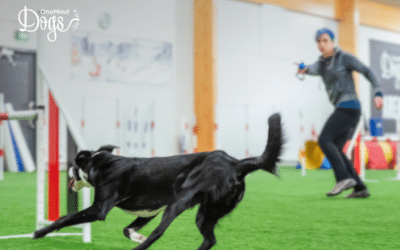OneMind Dogs Instructor Laurie Huston would like to share some great insights about the importance of planning in dog training. In Part One, she discussed planning as a way to avoid falling into the trap of “just one more time.” By planning ahead, we can dial in our training sessions to make them more effective and efficient. In Part Two, we’ll dig even deeper. The more we plan, the more streamlined our processes become. Effective planning helps you respond seamlessly in the moment. You’ll find yourself thinking, “I know exactly what to do—I planned for this!”
Routines: The Foundation of Clarity and Consistency
Routines are essential for bringing clarity, consistency, and connection into every training session. If we invest time and energy into developing solid routines early on, it can make a huge difference. Repetition builds familiarity and helps dogs learn what to expect, which is a critical part of creating clarity and consistency.
The time and space between getting your dog out of the car or crate and moving to the training area (and vice versa) are often overlooked, but these transitions are critical. By creating consistent routines in these spaces, we can enhance our dog’s understanding and behavior across different environments. Whether you’re training at home, in class, at a seminar, or at a trial, these routines should be consistent. This is a significant part of your planning process that is simply set on repeat. It is in that repetition that you will see benefits.
Here are some areas where routines can be particularly helpful:
- Entry and Exit Points: Be mindful of how you move through doors, gates, and entryways. Consistency here helps your dog understand what to expect.
- Transports: Whether moving your dog from the crate to the training area or between exercises, consistent transport builds routine and predictability.
- Potty Time: Establishing a routine for bathroom breaks helps define when and where it’s appropriate to potty (e.g., not on man-made objects or in the ring).
- Downtime: Agility training often involves waiting. Preparing your dog for breaks helps both of you stay calm and focused.
- Acclimation Time: Allow your dog time to assess their environment before starting training.
- Warm-Ups: Activate your dog’s body and mind for the work ahead.
- Leashing: Consistent leash routines set the tone for the session.
- Beginning and End of Run Routines: Rituals around starting and finishing runs signal your dog when it’s time to work and when the session is over.
- Cool Downs and Stretching: These routines help prevent injury, reduce muscle soreness, and let you notice subtle changes in your dog.
Each of these routines serves as a form of communication with your dog. Every behavior within these routines gives you valuable information. How your dog performs each behavior is an opportunity to check in and assess how things are going. Recognizing subtle changes in behavior allows us to address potential issues before they escalate into bigger problems. Often, small differences in these behaviors precede a dog having difficulty. Routines can help us identify these changes early.
Reward Planning: What, When, Where, and How
Having a variety of reward strategies in your toolbox is key to successful training. Food is often ideal for reinforcing thoughtful behavior during the acquisition phase, while toys can increase arousal, create distraction, and test behaviors. The location of the reward also matters. For example, when working on a behavior that relies on a hand cue or proximity, reward from your hand. For distance skills or forward focus, a pre-placed reward can reinforce the desired behavior in the moment.
Effective reward planning can make or break a session. Let’s break it down:
- What: What will you use as a reward? (e.g., food, toys)
- When: When will you cue reinforcement? Be intentional about which behavior you want to reinforce.
- Where: Where will you deliver the reward? (e.g., from your hand, a dish, or the ground)
Watch our Training Dog Agility By Yourself lessons to get some more great tips about this topic!
Preparing for Trials: Special Considerations
When preparing for trials, there are additional factors to consider:
- Reward Stashing: Teach your dog about delayed reinforcement and reward stashing. Start small with short work durations and gradually increase.
- Adding Variety: Expose your dog to different environments, equipment, and situations. Practicing routines and downtime in new locations is particularly beneficial.
- Equipment Familiarization: Try to expose your dog to various types of equipment before a trial, such as contact equipment, tunnels, weave poles, and jumps. Familiarity builds confidence.
- Socialization: Trials introduce many unknown factors, including crowds of people. Visit different places, like parks, to help your dog acclimate to distractions.
These are just a few considerations to help you get started. The possibilities are endless! Every time I step up my planning game, I see noticeable improvements in the quality of my training. Planning doesn’t have to be overwhelming—start small and build from there.
I hope incorporating planning into your training process brings you both joy and success!



